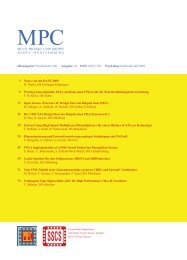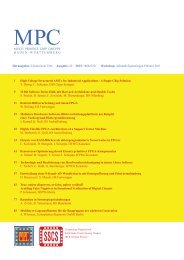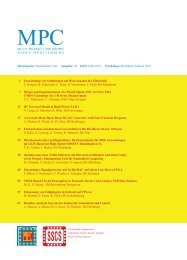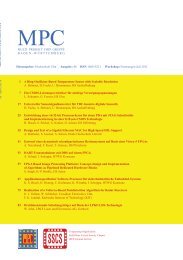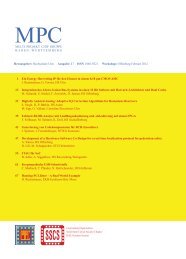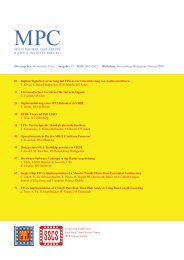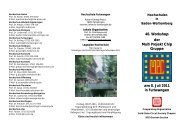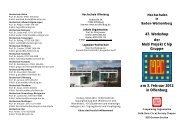[Geben Sie hier die Überschrift ein] - MPC
[Geben Sie hier die Überschrift ein] - MPC
[Geben Sie hier die Überschrift ein] - MPC
- TAGS
- mpc.belwue.de
Erfolgreiche ePaper selbst erstellen
Machen Sie aus Ihren PDF Publikationen ein blätterbares Flipbook mit unserer einzigartigen Google optimierten e-Paper Software.
<strong>MPC</strong>-WORKSHOP JULI 2012<br />
Fig. 8: Vehicle as a complex sensor/actuator node.<br />
are distinguished on the E/E architecture toplevel,<br />
backbone architecture, centralized architecture and<br />
front/rear architecture (see Fig. 7). The larger blocks<br />
represent domain gateways which route information<br />
between the different bus segments that are existent in<br />
the overall E/E architecture. In the case of a centralized<br />
architecture only a single gateway is available<br />
that connects all bus segments. The central gateway<br />
approach has the advantage of information from all<br />
bus segments b<strong>ein</strong>g directly accessible within a single<br />
control unit without additional latency, introduced e.g.<br />
by a backbone connection. As described below, this<br />
kind of topology is advantageous when opening the<br />
internal vehicular network to an outer Vehicular Ad<br />
hoc NETwork (VANET).<br />
D. E/E Architecture Design for V2XC<br />
Vehicle-to-X Communication (V2XC) based on a<br />
VANET forms the next major step for extending the<br />
automotive domain towards smart mobility. V2XC<br />
promises improvements in situation awareness, traffic<br />
management and active safety based on disseminated<br />
information. A VANET is a highly dynamic sensoractuator-network<br />
with vehicles as nodes. Depending<br />
on the density of equipped vehicles, a varying number<br />
of geologically distributed VANETs may merge or<br />
separate depending on the participant’s movements.<br />
Up to now, most research in the V2XC domain ends<br />
up in describing protocols, application analysis and<br />
standardization. Only limited effort is put into realization<br />
and system architecture aspects. However, considering<br />
vehicles as a simple network node while<br />
neglecting the fact of up to around 100 devices communicating<br />
inside which cause highly diverse internal<br />
latency times and throughout rates, is not enough for<br />
getting a holistic view. Beside predictable latency<br />
times, trustworthiness of messages is a major aspect<br />
since safety relevant decisions have to be based on<br />
remotely collected information to overcome line-ofsight<br />
limitations. Security measures based on cryptographic<br />
algorithms have to be employed which typically<br />
demand for a huge amount of computational<br />
power. In Fig. 8 these facts are illustrated by means of<br />
Fig. 9: V2X-gateway architecture.<br />
a single vehicle that is connected through a V2X interface<br />
to a smart environment which allows data exchange<br />
between external and internal network consisting<br />
of a complex interconnection structure of sensor<br />
and actuator systems.<br />
In this context we developed a FPGA-based V2X<br />
gateway architecture (see Fig. 9) [7] which follows the<br />
last North American and European standardization<br />
efforts [8]-[10]. By integration of V2X functionality<br />
into a central automotive gateway, a direct link between<br />
the VANET network and the internal vehicular<br />
bus network is provided. The approach opens the<br />
internal automotive E/E architecture to the outer<br />
VANET. Therefore, the central gateway is divided<br />
into an Inter-Vehicle-Networking-Domain (InterVND<br />
and an Intra-Vehicle-Networking-Domain (IntraVND).<br />
The main aspects which make this approach<br />
different are as follows:<br />
• Modularization: Typically occurring tasks are<br />
distributed on specific modules. These work in<br />
parallel and allow processing of V2X messages in<br />
discrete steps. Each of the modules consists of<br />
different hardware and software components and<br />
fulfill a dedicated task like e.g. message evaluation,<br />
routing, signature generation/verification or<br />
information processing. Thus the overall gateway<br />
itself forms a heterogeneous multicore device.<br />
Self-X characteristics have been embedded into<br />
the system wherever possible e.g. by utilizing partial<br />
dynamic reconfiguration.<br />
• Communication Architecture: Packets are passed<br />
from one module to the successor in the processing<br />
chain by means of a realtime capable on-chip<br />
packet-based transmission bus system [11]. Especially<br />
in situations like traffic jam when the own<br />
vehicle is surrounded by dozens of other vehicles<br />
and the system runs near maximum capacity, a<br />
fast forwarding of crucial information must be<br />
guaranteed in order to comply with the strict latency<br />
requirements. Accelerating packet propagation<br />
is achieved by prioritized packet forwarding<br />
through prioritized scheduling and prioritized re-<br />
5


![[Geben Sie hier die Überschrift ein] - MPC](https://img.yumpu.com/8654082/8/500x640/geben-sie-hier-die-uberschrift-ein-mpc.jpg)
